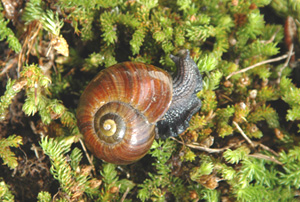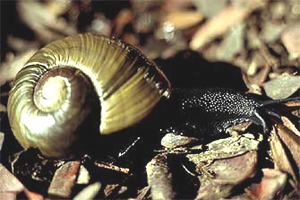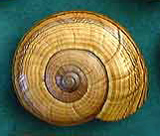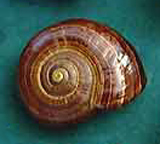 |
 |
 |
 |
 |
 |
 |
 |
 |
 |
|
|
  |
|
Home > Environmental Issues > Article |

High risk of extinction from Powelliphanta snail translocation12 April 2006Conservation Minister Chris Carter and Associate Minister of Energy Harry Duynhoven have approved permits under the Wildlife Act to enable a population of Powelliphanta 'Augustus' snails to be moved from the Mt Augustus ridgeline on the West Coast. The state-owned mining company Solid Energy New Zealand, plans to extract high quality export coal with a value of NZ$400 million (US$246 million) from the Stockton opencast mine. The company must implement mitigation measures to preserve the snails before it can commence mining. Chris Carter has acted against the recommendation of the Department of Conservation, the agency under his authority, that the snails should not be moved. Solid Energy will relocate up to 250 snails by hand to a 10ha site, establish a new snail habitat that will not be affected by mining, provide protection with intensive predator control and a predator proof fence, protect an expanded proportion of the existing snail habitat that will not be mined, develop a captive management programme, and conduct a wider survey of the surrounding environment to locate other possible habitat for Powelliphanta 'Augustus'. |
A Department of Conservation report states that not mining the site is the only option that ensures Powelliphanta 'Augustus' does not become extinct. |
|
The critically endangered species is fully protected under the Wildlife Act, but the current action of the Conservation Minister puts the already depleted population at a high risk of extinction. There have been no previous translocations, and it is not known whether the snails will successfully re-establish on a new site. Chris Carter has also acted against the scientific advice of the Biodiversity Committee of the Royal Society of New Zealand. The Committee commented that "... the evidence that this population of snails has not expanded its territory, and that its habitat is so restricted, both suggest the necessity to protect the original habitat ..." The Committee questioned how likely is it for a top order carnivore to successfully survive immediately on re-release to a new habitat into which it has not spread to date, and suggested that these scientific questions need to be answered before the destruction of the original habitat. Powelliphanta 'Augustus' has not expanded into the nearby new location which is just 800m away. The altitude, solar aspect, exposure, diversity of vegetation, and soil chemistry are all different at the new site. It is not known whether the species can be held in captivity successfully. There is no experience with captive breeding. Like so many of New Zealand's rare indigenous species, Powelliphanta 'Augustus' is slow to breed, does not reach maturity and breed until five or six years old, and lives for up to 20 years. If the translocation and the captive management programme do not succeed there is no fall back position. Mining will have already have done its damage. DoC stated in its comments on Solid Energy's draft application "... the tight timeframe for this proposal is its undoing. The 'rush' attaches huge risk to the proposal ... to eliminate risk the timeframe required is years. Ideally before considering risking the only source population through habitat movement the success of translocation should be confirmed. Snails should be translocated in several batches over several seasons and then monitored until at least breeding of the translocated and captive populations was confirmed ..." Solid Energy estimates moving and protecting snails on the Mt Augustus ridgeline will cost $8000 per snail. "Relocation of the snails from Mt Augustus will cost us in the vicinity of upwards of $2 million" Solid Energy communications director Vicki Blyth said. Nothing is standing in the way of mining .....This decision on Powelliphanta translocation clearly demonstrates the government's prevailing policy to prioritise the extraction of energy sources and minerals at any cost to the environment. When announcing his decision, the Conservation Minister said "... should a population of very rare and apparently very localised snails be moved out of most of their known habitat? And if not, is the risk of moving the snails sufficiently high to halt Solid Energy's mining plans on the Mount Augustus ridgeline? ..." Chris Carter admitted the risk of extinction when he stated "... It is fair to say the scientific information on Powelliphanta 'Augustus' is heavily contested. There are a large number of unknowns, risks and scientific arguments around key aspects of the species, and what will happen if they are moved ..." "However, as ministers we have a legal responsibility to consider more than just the welfare of the snails" Mr Carter said. "We are also required to have regard to the Coal Mines Act, and this piece of legislation demands that we consider the economic benefits that flow from the efficient development and use of New Zealand's coal resources" the Minister said. The Minister of Conservation is also required to have regard for the Wildlife Act and the protection of endangered species. Much of the existing habitat for Powelliphanta 'Augustus' has already been destroyed, and surrounding mining activity has degraded what is left. The Minister added "In making our decision, we have had to weigh the economic benefits of accessing this coal resource with the potential risk of detriment to the snails." In other government actions that give mining priority, the Minister of Conservation has been very silent. Crown Minerals has had a free hand at issuing two mineral prospecting licences to Seafield Resources Limited, which is principally looking for gold on the seabed along more than 400km of the west coast of the South Island, covering 10,178 sq.km and extending to the edge of the 12 nautical mile territorial sea and beyond. Westland Tai Poutini National Park and part of Mount Aspiring National Park extend from the alps to the coastline that is subject to the licence. The two parks are part of the pride of New Zealand conservation interests, the Te Wahipounamu - South West New Zealand World Heritage Site which also includes Aoraki/Mount Cook National Park, and Fiordland National Park. The coast is the habitat of two important species, the protected New Zealand fur seal, and endangered Hector's dolphin. When Powelliphanta 'Augustus' goes extinct, the government can be held directly responsible. |

K.J. Walker Crown Copyright © Dept. of Conservation
|
||
|
Powelliphanta snails originated about 200 million years ago, and belong to the oldest family of carnivorous land snails on Earth. Together with New Zealand's other primitive species, tuatara, Leiopelma frogs and weta, land snails are regarded as living fossils because of their ancient lineage. Photos left:
|
|
There are 21 known Powelliphanta species and 51 subspecies. They occur in a few isolated pockets in the Central North Island, on the Kapiti Coast, and across Cook Strait in Marlborough. The greatest diversity of species is in the mountains of northwest Nelson and north Westland. Isolated locations occur down the West Coast to Fiordland and Southland. Most species occupy small isolated areas, as a result of substantial habitat loss. Snails are also threatened with predation by possums, pigs and rats. Powelliphanta snails vary in size but some are gigantic - up to 90mm across. The largest is P. superba prouseorum in Kahurangi National Park. It is the size of a man's fist, and weighs 90g which is as much as a tui. Biological oddities in a vastly different snail fauna.....New Zealand's long isolation, the absence of mammals, a rugged and divided topography, changing biogeographical conditions, and a varied climate have influenced the radiation of a unique and magnificent snail fauna that represents the country's distinct Gondwana heritage. In addition to the giant carnivorous land snails, there are about 1500 microscopic species that are the size of a pinhead and are mainly vegetarian. Powelliphanta were previously known as Paryphanta, before being classified as a separate genus in the 1970s. Two species of the genus Paryphanta (Kauri snail), and another 3 Placostylus species (Flax snail) are only found in the Northland region. They are also pretty big and carnivorous. The Kauri snail goes a step further with cannibalism. The larger Paryphanta species P. busbyi has a shell diameter of 79mm, and Placostylus bollonsi has a shell length of 115mm |
 |
|
Kauri snail Paryphanta busbyi |
|
|
All species of Powelliphanta, Paryphanta and Placostylus land snails are endemic to New Zealand. The shiny, colourful shells of land snails are quite beautiful. Shell patterns vary considerably with species, with many delicate bands in shades of black, brown, red or yellow. The beauty of the shells was fatal for many land snails, before shell collecting became illegal in 1982. Powelliphanta snails are difficult to find because they are nocturnal, coming out at night to feed and mate. Earthworms are their favourite food, and they also eat slugs. An extraordinary physiological feature is that Powelliphanta are hermaphrodites. They have female and male reproductive organs and can mate with any other mature Powelliphanta. Each year, they lay 5 to 10 pink coloured eggs that are up to 14mm long, with hard shells like a bird's egg. |
 |
 |
home | sponsors | latest news & events | join - donate | contact information | projectsvolunteer activities | about us | site map | environmental issues | New Zealand ecology |
 Status of six birds improve and ten worsen in the latest New Zealand threatened species list
Status of six birds improve and ten worsen in the latest New Zealand threatened species list
 View larger image
View larger image
